Oakland Athletics: Four Reasons They Should Release Billy Butler

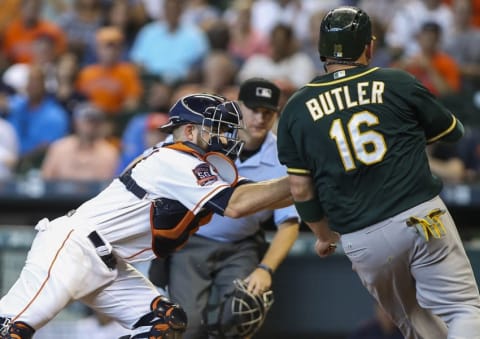
Four Reasons The Oakland Athletics Should Release Billy Butler
In November of 2014, the Oakland Athletics signed Billy Butler to a three year $30 million contract. This raised eyebrows not only because it was unlike Billy Beane to go after high-profile free agents, but also because it was uncharacteristic of the A’s to pursue players as inflexible as Butler. In a club that lives and dies by the platoon, where would Butler fit in?
Critics of the signing, including myself, noted that Butler’s performance actually showed a downward trend since his All-Star 2012 season. Each of the following seasons showed lower average, OPS, and home run totals. Since he doesn’t help the team defensively, these were truly his only metrics that mattered.
And in 2015, he disappointed again.
The Athletics still owe Butler more than $23 million over the next two seasons, but it’s time for the organization to consider eating the money they owe him and move on to other players.
There are unlikely any teams that are willing to pay the full price to have Butler on their roster, but that doesn’t necessarily mean that there aren’t teams that are completely unwilling to just have him on their roster.
That’s right, the Athletics can do themselves a favor by eating the $23 million they owe him by paying him to play for another team or just releasing him. And there is precedent that demonstrates that this is a sometimes necessary move for teams to make.
We’re going to take a look into past instances where teams were facing an expensive contract that ate up valuable spots on the 25-man roster, and examine how they justified absorbing the salaries of these players.
Next: First: A Cubs Pitcher
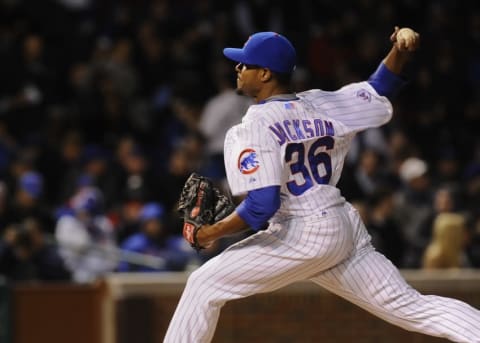
Edwin Jackson
The winter of 2013 was Theo Epstein’s first full offseason as the Chicago Cubs general manager. He was fresh off of a low-expectations 2012 season where the Cubs finished last in the National League Central, and Cubs fans were eager to see how their new general manager would turn their franchise around (just as he had done in Boston).
That is why they were shocked to hear that the Cubs signed right-handed starting pitcher Edwin Jackson to a four-year $52 million contract. At this point in his career, Jackson had been in the league for ten seasons and had played for seven different teams. He was no doubt a veteran presence, but he was 70-71 for his career with a 4.40 ERA at that point. The expensive long-term contract was certainly a head scratcher.
More from White Cleat Beat
- Lucas Luetge what Oakland A’s need in bullpen
- Oakland A’s bring Deolis Guerra back on minor league deal
- How much will Oakland A’s improvements matter in 2023?
- Oakland A’s giving Drew Rucinski a chance to prove himself
- The pain of the Oakland A’s first round draft picks
Jackson pitched for two years as a starter, and was relegated to long relief duty in 2015 after the Cubs settled on five other pitchers they’d rather have starting. In his two and a half seasons in Chicago, he pitched 5.37 ERA baseball through 347 innings.
Spring Training of 2015 should have served as an omen for Jackson’s future in Chicago. On a day he was scheduled to start against the Athletics, his GPS navigated him to the A’s old spring training venue. Consequently, he was late and could not enter the game until the second inning. He gave up eight runs in 1.2 innings.
The Cubs parted ways with Jackson in July, understanding that they still owed him the remainder of his $11 million salary for 2015 in addition to another $11 million for 2016.
It is true that the Cubs ate a hefty chunk of Jackson’s salary, but it allowed them to optimize the talent in their pitching staff. Their starting pitching staff was ranked third in all of baseball in 2015 with a 3.36 ERA, so the lost $11-plus million probably doesn’t keep the front office up at night.
Next: Next: A Braves Infielder
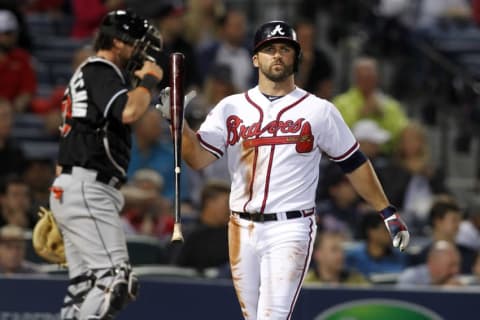
Dan Uggla
When the Braves acquired Dan Uggla from the Florida Marlins in November of 2010, they thought they had just found a slugger to carry them into the future. It was a year that right-handed power hitting was rare and expensive in the free agent market, so the Braves came out of this trade thinking they had it made.
The Braves organization had so much faith in Uggla that they signed him to a five year deal worth over $60 million.
But then the games started, and then-general manager Frank Wren soon realized the grave mistake he made by offering that contract.
Uggla did slug 36 home runs in his first season with the Braves, but that was more of a consolation prize given the 156 times he struck out that season. The tepid .233 average he managed to hit in his debut season in Atlanta was actually the best he would ever muster during his tenure there, deteriorating to as low as .162 by the time he was DFA’d and ultimately released in 2014.
More from Oakland A's News
- Lucas Luetge what Oakland A’s need in bullpen
- Oakland A’s bring Deolis Guerra back on minor league deal
- How much will Oakland A’s improvements matter in 2023?
- Oakland A’s giving Drew Rucinski a chance to prove himself
- The pain of the Oakland A’s first round draft picks
According to the AP report published by ESPN, Wren explained that the front office had been veritably begging for other teams to accept a trade that included Uggla. When nobody took the bait, the Braves were forced to release him and surrender the $18 million still guaranteed on his contract.
The Braves won the NL East in 2013, and didn’t include Uggla on the playoff roster. This spelled the beginning of the end, as the club released him early in the 2014 season.
The Braves still haven’t quite figured out their second base situation, but the lesson is that tinkering with the carousel platoon of Jace Peterson, Gordon Beckham, and Kelly Johnson will still be more productive than it would have been to see Uggla through to the end of his contract.
Similarly, if the A’s move on from Butler, they will be able to give Mark Canha – who gives the A’s a lot more offensive production per dollar than Butler does – more opportunities to hit from the DH slot, as well as give Stephen Vogt days off from catching while still utilizing his bat. The A’s will have the opportunity to see which combination of hitters gives them the best production at the DH position, rather than spending two years hoping Butler turns it around.
Next: Next: A Pirates Pitcher
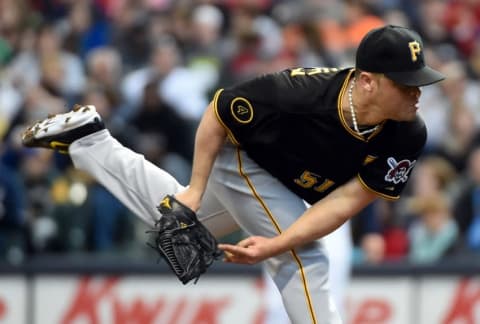
Wandy Rodriguez
The previous two examples did occur on teams with higher payrolls than the A’s. Wandy Rodriguez, on the other hand, was a piece that forced a fellow low-payroll team to make a difficult decision.
The Pittsburgh Pirates acquired Rodriguez from the Houston Astros in 2012 to bolster a rotation that relied heavily on ace A.J. Burnett and less-than-reliable performances by James McDonald and Kevin Correia.
The circumstances that led to Rodriguez’s release weren’t even so much that he was performing badly as much as they just seemed to be a star-crossed pair. Wandy did provide the extra punch that that rotation needed in 2012, holding onto a solid 3.72 ERA through 75.0 innings. He was just unable to stay healthy enough to sustain that kind of performance.
The innings he pitched in 2013 were quality innings, but injuries limited him to just 62.2 innings through twelve starts the entire season. His 2014 season got off on the wrong foot when a right knee problem kept him out of commission for three weeks. Clearly off his game, his performance suffered badly in the six starts he did make with Pittsburgh that season.
The Pirates were forced to designate Rodriguez for assignment in late May 2014 in order to make room for Russell Martin. The club understood that his high salary and recent injury woes would make the prospect of another team claiming him off waivers unlikely.
Even with the Astros kicking in $5.5 million of Rodriguez’s salary for that year, the Pirates reportedly still owed him about $5.3 million for the rest of the season. The Pirates’ total payroll for 2014 was just over $78 million. You can bet that it nagged at their front office knowing that 7 percent of their payroll was tied up in a player that wouldn’t be on the field for the rest of the season.
But the Pirates were a better team for it. Eating Rodriguez’s salary hurt, but the Pirates fielded six starting pitchers that year who all threw over 100 innings and maintained ERA’s under 4.00.
The Pirates made it to the wildcard round that season, but were eliminated by the eventual World Series champion San Francisco Giants.
Next: Finally: An Indians Infielder
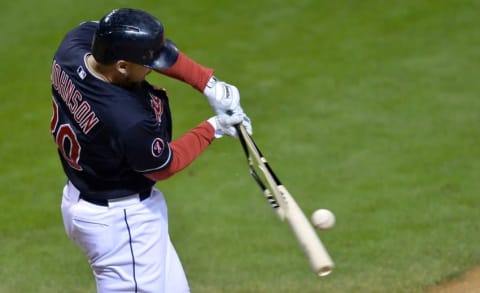
Chris Johnson
In 2015, the Cleveland Indians achieved what everybody thought was impossible when they traded away Michael Bourn and Nick Swisher. Both of these players had hefty contracts with the Tribe and were underperforming, so they were seen as two gigantic drains on the team’s resources. Nobody thought they would be able to find suitors interested in these two and their contracts.
What they got in return, however, was Chris Johnson. He is owed $7.5 million in 2016 and $9 million in 2017, and doesn’t have a buyout option until 2018.
Johnson did see a jolt in production as soon as he joined the Indians, bumping his season average from .235 with the Braves to .289 with the Tribe. His 27 games with Cleveland looked promising until he was sidelined by a freak spider bite that caused runaway swelling in his hand.
The Indians were confronted with a decision, however. Did they want to take a chance on Johnson for the next two years, having just resolved their Bourn and Swisher debacle? Or would they rather just thank Johnson for his 27 games and send him away with his money?
The free agent market helped make this decision for Cleveland, when they signed Rajai Davis to a contract over the offseason. When they needed to make a roster spot for Davis, Johnson was the first to go, even if they still owed him $17 million.
The Indians are another small payroll team like the A’s, and they will certainly feel the effects of paying Johnson, as well as helping the Braves pay for the remainder of Bourn and Swisher’s contracts. But take a look at the Indians’ depth chart for their expected 2016 starting lineup. Davis adds to a new-look outfield, while Francisco Lindor will join All-Star Jason Kipnis and newly acquired Mike Napoli to round out the infield. The Indians are a better team for letting go of their bad contracts.
Next: Former A's Relievers Flock To Seattle
And it’s time for the A’s to do the same thing with their designated hitter. The A’s will be a better team if the front office can admit that this signing was a mistake and gracefully move on from the Billy Butler experiment.